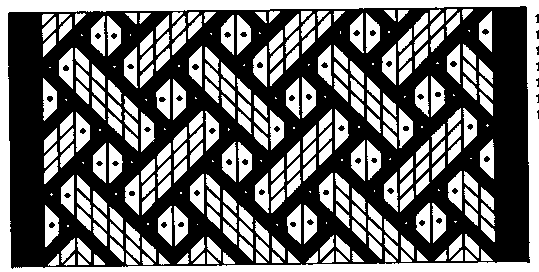

This document is provided as is without any express or implied warranties. While every effort has been taken to ensure the accuracy of the information contained, the author assumes no responsibility for errors or omissions, or for damages resulting from the use of the information contained herein.
Permission is granted to make and distribute verbatim copies of this document for non-commercial private research purposes provided the copyright notice and this permission notice are preserved on all copies.
This document was originally published in the December 1993 Arts and Sciences edition of Pikestaff, the newsletter of the East Kingdom, Society for Creative Anachronism, Inc.
Copyright © 1993 Carolyn Priest-Dorman.
The motif for this tablet-weaving "recipe" is based on a Viking Age brocaded tablet-weaving pattern found on Bands 22 and 23 at Birka, Sweden. Based on both the number of finds of brocaded tablet-weaving finds and the total weight of metal brocading weft found at Birka, this was the trim pattern most commonly represented in Birka's Viking Age burials; its popularity spanned the ninth and tenth centuries.[1] This recipe adapts the brocaded pattern to a technique which is familiar to many SCA tablet-weavers. It is a recipe because it relies not on the weaver's knowledge of the theory behind the technique but on the ability to follow a prescribed draft and turning sequence.
The technique used in this recipe is a modification of the so- called "Egyptian diagonals" or "diagonal double-turn" technique. Many modern books on tablet-weaving include patterns based on the principle of Egyptian diagonals: groups of tablets threaded with two dark and two light strands are turned alternately forward and back in shifting patterns in order to bring up a design based on diagonal stripes of equal width. Like the modern patterns, most surviving European pieces from the early Middle Ages that include the Egyptian diagonals technique (such as the tenth-century Girdle of Witgarius) also utilize two light and two dark threads per tablet. However, according to Collingwood there is an extant Coptic piece which utilizes one dark and three light threads, like this recipe does.[2] The one-three threading facilitates the designing of a whole different class of patterns that display stripes of unequal width, including the one described here.
In order to use this recipe, first thread your cards to correspond to the draft below. Remember, heraldry works; if you choose a metal for your "light" and a tincture for your "dark" color, you'll get a particularly striking band that contrasts well and really does sort of look like metal brocading. This pattern is not suited to color choices such as blue/red or green/purple: your eyes will get very tired of looking at such combinations while you weave, and you might even get nauseous!

Each vertical column of the draft represents the four holes in a single card; the four squares on the draft, from top to bottom, stand for holes A, B, C, and D of the card. All the threads in one card must be threaded in the same direction, either S-wise or Z-wise. The draft is read from left to right so that Card 1 is at the left of the pack as you weave. You can widen the pattern by adding additional sets of eight cards between Cards 26 and 27 of this recipe; thread each additional set just as Cards 3-10 are threaded. When you are ready to weave, make sure all your cards are set up so that the holes A and D are above the shed and holes B and C are below it. Then repeat the 8-turn turning sequence (see below) as many times as necessary.

Collingwood, Peter. 1982. The Techniques of Tablet Weaving. New York: Watson- Guptill.
Geijer, Agnes. 1938. Die Textilfunde aus den Gräbern. Birka: Untersuchungen und Studien III. Uppsala: Almkvist and Wiksells B.A., Kungl. Vitterhets Antikvitets Akadamien.
This page was created on 28 February 1997 and last updated on 5 March 1997.
Search this site | Back to Þóra's Textile Resources | Back to Þóra's Viking Resources
No soliciting!capriest@cs.vassar.edu